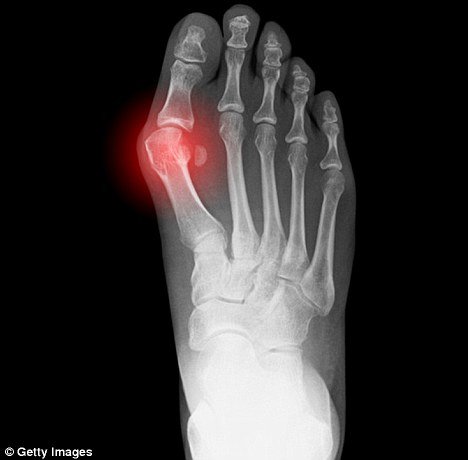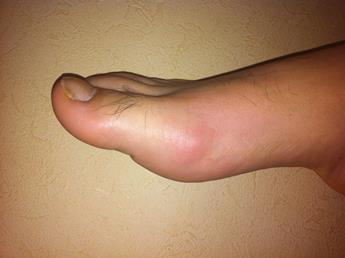Joseph R Anticaglia MD
Medical Advisory Board
Gout is the most common type of inflammatory arthritis causing attacks of severe pain and swelling in your joints. Ninety percent of the time it affects men over the age of 30 and when it affects women, it usually involves postmenopausal women.
Gout is caused by too much uric acid in the blood (hyperuricemia) and in the tissues. At a certain point, uric acid forms crystals in the joints which the immune system attacks causing redness, swelling, warm and painful joints. The big toe is especially affected by gout and the slightest touch of the hot toe can elicit intense pain. Other joints can be involved and this condition can become chronic.

Uric acid is the by-product of the breakdown of purines, substances found in food and beverages such as beer, anchovies, fructose and liver. Ordinarily, uric acid breaks down in the blood, crosses the kidney on its way out of the body in the urine. But primary and secondary factors can cause a buildup of uric acid in the blood, forming crystals in the joints leading to gout.
Primary gout
Primary gout has a hereditary component linking gout to genes that regulate uric acid by the kidney. Families and their offspring have an increased risk to develop gout and periodic attacks of this painful condition.
Secondary gout
A spike in the incidence of gout has been correlated with the rise in obesity. Alcohol excess, particularly beer, promotes increased uric acid production and decreased excretion of uric acid by the kidneys.
Sugary drinks high in fructose, chronic kidney disease, medications such as low dose aspirin, diuretics and certain immunosuppressant drugs used in transplant patients predispose a person to gout.
Also, certain diseases causing abnormalities in the structure of hemoglobin can lead to hyperuricemia and gout. Hemoglobin is the component in red blood cells that provides the body with oxygen from the lungs to the tissues and the removal of carbon dioxide from the tissues in the body.
The Rich and the Not so Rich
Once called “the disease of kings,” gouty arthritis is not solely a royal affliction. People have images of Henry the VIII holding a slab of meat in one hand and a glass of wine in the other and associating him with gout. People from all walks of life have been afflicted with this problem. Benjamin Franklin, author and poet Samuel Johnson, basketball hall of famer Maurice Cheeks, as well as working man Danny B. have agonized over gout.
Danny B. works in the garment district in a dress shop. He enjoys beer at home and with his friends in their favorite bar. When he drinks with his friends, he has a peculiar habit of leaving about an inch of beer in the bottom of the glass before ordering another beer. One day, he didn’t show up for work and described what he experienced this way:
“Mike and me and a few of the fellows had a few too many beers one night. Around 2:30 the next morning, I woke up with excruciating pain in my right toe. I had to take the sheets off my foot because anything that touched that toe made me yell for mercy.
The toe was swollen and red and I couldn’t move it. I couldn’t walk or do anything with that foot because of the toe. I called my doctor who called in medicines that worked to cut down on the pain. It took a while but it worked. What a miserable night. When I saw him later that day, I couldn’t thank him enough.”

Symptoms
Gouty arthritis attacks come on suddenly and frequently at night. Alcohol excess and changes in urate sensitive medications are two reasons that precipitate the attacks. As noted, an attack
causes red, swollen, warm painful joints. The big toe is the most susceptible joint (‘podagra’) and the pain becomes more intense as the attack progresses.
Other joints may become involved and there can be a quiet interval of months or years after the first attack. Furthermore, gout can become chronic with deformity of the joints mimicking rheumatoid arthritis.
Diagnosis
During an acute attack, urate crystals aspirated from the fluid in the joint establishes the diagnosis of gouty arthritis. Crystal can also form ‘tophi’ or growths under the skin over a joint or on the outer ear. Blood measurements can also help establish the diagnosis of gout. However, clinical history and findings usually suffice to make the diagnosis
Treatment
‘Acute’ Attacks
- Management aims to reduce inflammation and to control pain.
- NSAIDS stands for non-steroidal, anti-inflammatory drugs and are very effective treatment for acute gout.
- Corticosteroids control most attacks with dramatic symptomatic relief.
- Colchicine is an anti-inflammatory drug that’s useful if started within the first 36 hours of the acute attack
Time between Attacks
- Management between attacks aims to prolong symptom free periods (reduce flare-ups)
- Use of medications to lower elevated blood uric levels to an acceptable range
- Encourage lifestyle changes (avoid alcohol, lose weight, avoid sugary drinks-dietary changes-minimize foods rich in purines)
Everyone seems to be susceptible to gouty arthritis. The more you know about gout, the greater the likelihood you can live without it.
References
- NIH, NIAMS; Gout; April 30, 2016
- American College of Rheumatology; Guidelines for Management of Gout, 2012
- David Hellmann and John B. Imboden Jr.; Rheumatologic, Immunologic & Allergic
- Disorders; Current Medical Dx & Rx, 2018
- Gout, Fast Facts; American College of Rheumatology, 2018
This article is intended solely as a learning experience. Please consult your physician for diagnostic and treatment options.

